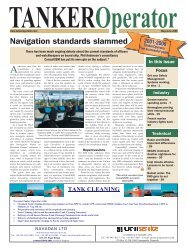Features: - Tanker Operator
Features: - Tanker Operator
Features: - Tanker Operator
Create successful ePaper yourself
Turn your PDF publications into a flip-book with our unique Google optimized e-Paper software.
TECHNOLOGY - TANK CLEANING<br />
The Science of Cargo<br />
Tank Cleaning<br />
If you ask any commercial or operational management company of a chemical<br />
or petroleum product tanker, they will probably say that tank cleaning<br />
is the Achilles Heel of the entire operation*<br />
Certainly it is the rate determining<br />
step and very often it is the main<br />
reason why a vessel may or may<br />
not load its nominated cargo.<br />
But contrary to what you may hear, tank<br />
cleaning is not difficult; it is sometimes<br />
confusing and very often frustrating, but there<br />
is always a reason why something has<br />
happened and identifying this reason will very<br />
often resolve a problem. The importance of<br />
experience can of course never be underestimated,<br />
but as a great deal of experience has<br />
already retired, or is in the process of retiring, it<br />
has to be said that experience is not critical.<br />
It is actually noticeable that the days of the<br />
little 'black book' containing tank cleaning<br />
secrets are clearly becoming numbered, not<br />
just because the number of individuals with<br />
the experience is decreasing but also because<br />
many of the most effective tank cleaning<br />
secrets are pre-MARPOL regulations and<br />
based on using tank cleaning materials that are<br />
now prohibited.<br />
The use and availability of tank cleaning<br />
materials today is far more strictly controlled<br />
in terms of marine pollution, but as a direct<br />
consequence, the potency of many of tank<br />
cleaning materials has diminished, which does<br />
have an impact on the tank cleaning.<br />
Safety is also a far more significant concern<br />
and the tendency is to only use tank cleaning<br />
materials that are non hazardous, non toxic<br />
and non flammable. This too also affects the<br />
efficiency of the tank cleaning materials and<br />
does have a bearing on the tank cleaning,<br />
particularly when coated cargo tank surfaces<br />
are involved.<br />
When one considers that most tank cleaning<br />
materials are detergent based and detergents<br />
contain surface active ingredients, it is clear<br />
that the primary role of such products is to<br />
'clean the surface of the cargo tanks'. If the<br />
cargo tanks are lined/plated/clad with stainless<br />
steel, these products are completely<br />
satisfactory, but if the cargo tanks are lined<br />
with organic or inorganic based paints that<br />
allow previous cargo residues to become<br />
A large cargo tank with a deepwell pump, drop line and a cleaning machine.<br />
trapped inside the matrix of the coating, surface<br />
active cleaning materials are largely ineffective.<br />
This is mainly common sense, but knowing<br />
and understanding this is sometimes difficult<br />
to comprehend when there are apparently no<br />
other solutions available.<br />
What is tank cleaning?<br />
All tank cleaning procedures are a logical<br />
sequence of events that will ultimately lead to<br />
the objective of loading the next nominated<br />
cargo. The precise nature of the cleaning<br />
process is specifically determined by the<br />
chemical and physical properties of the cargo<br />
being cleaned from, the type of lining inside<br />
the cargo tanks, the size and dimension of the<br />
cargo tanks and the pre-loading specifications<br />
of the next nominated cargo.<br />
The key to any successful cleaning<br />
operation is very simply knowing how far to<br />
clean and determining whether each step of<br />
the cleaning has been effective.<br />
In practice most tank cleaning procedures are<br />
very similar, because there are not that many<br />
different variables available to the vessels:<br />
i) Fixed tank cleaning machines or portables<br />
(or both).<br />
ii) Water or solvent for the pre-wash?<br />
iii) Reaction of the previous cargo(s) with the<br />
cargo tank coating.<br />
iv) Cold water or hot water?<br />
v) Tank cleaning materials or not?<br />
Determining the correct plan is essential, but<br />
this can usually be gained from the many and<br />
varied tank cleaning guides available on the<br />
market. Of far greater significance and<br />
importance is the monitoring of each step of<br />
the plan, in order to make sure that it has<br />
actually been carried out.<br />
Tank cleaning guides are useful but they can<br />
also be extremely misleading for the simple<br />
reason that inexperienced operators will tend to<br />
use the guides as a definitive method for any<br />
particular tank cleaning. This is a mistake which<br />
can and does cause problems.<br />
Still today in legal disputes on whether a<br />
vessel is deemed to have cleaned (or not as<br />
the case may be) with "due diligence" in the<br />
preparation of the cargo tanks prior to loading<br />
the nominated cargo, legal reference is drawn<br />
August/September 2008 � TANKER<strong>Operator</strong> 57

















